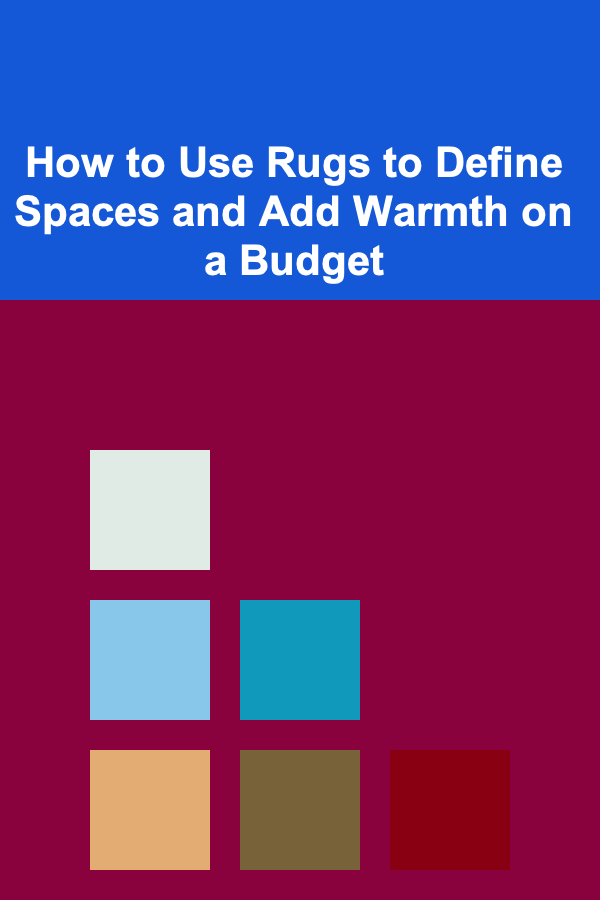
How to Use Rugs to Define Spaces and Add Warmth on a Budget
ebook include PDF & Audio bundle (Micro Guide)
$12.99$8.99
Limited Time Offer! Order within the next:

When it comes to home décor, few items have the transformative power of a well-placed rug. Rugs are not only functional, providing comfort underfoot and helping to reduce noise, but they can also define spaces, add warmth, and elevate the overall aesthetic of a room. Whether you're looking to create a cozy atmosphere, delineate areas in an open-plan layout, or simply add a pop of color and texture, rugs can do it all without breaking the bank.
In this article, we'll explore how to use rugs to define spaces and add warmth in a budget-friendly way. We'll cover the types of rugs to consider, tips on selecting the right size and style, and how to strategically place them in your home to achieve maximum impact.
The Role of Rugs in Interior Design
Rugs are more than just decorative elements---they serve several important functions within a space. In terms of design, rugs can:
- Define and Zone Areas: In large or open-concept spaces, rugs can help delineate different functional areas, such as the living room, dining area, and workspace.
- Add Warmth and Comfort: Rugs provide a soft, cushioned surface that adds warmth, both physically and visually. This can make a space feel more inviting and comfortable.
- Introduce Texture and Color: Rugs can add depth and texture to a room, enriching the overall design. They are also an excellent way to introduce color without committing to bold wall paint or expensive furniture.
- Anchor Furniture: A rug can tie together various pieces of furniture, creating a cohesive and harmonious look.
While rugs are often seen as a luxury item, they don't need to be expensive to fulfill these functions. With the right approach, you can use rugs to enhance your space on a budget.
Types of Rugs and Their Functions
Before diving into how to use rugs in your home, it's important to understand the different types of rugs available and how each can serve a distinct purpose in your space. There are several factors to consider when choosing a rug, including material, style, size, and texture.
2.1. Area Rugs
Area rugs are large enough to cover a portion of the floor, typically placed in the center of a room. They are versatile and can be used to define specific areas, such as a seating arrangement in the living room or a workspace in a home office.
- Function: Area rugs help anchor furniture arrangements, define seating areas, and add visual interest to large rooms.
- Budget Tip: Look for synthetic fibers like polypropylene or nylon for a more affordable option, as these materials are durable and relatively inexpensive.
2.2. Runner Rugs
Runner rugs are long, narrow rugs that are typically placed in hallways, entryways, or along the sides of a bed or dining table. They can add a stylish touch to spaces that may be too narrow for larger area rugs.
- Function: Runner rugs can protect high-traffic areas like hallways and entryways while also adding warmth and texture to narrow spaces.
- Budget Tip: Consider cotton or wool runners for durability and softness. They are often more affordable than larger area rugs and provide a significant design impact in smaller areas.
2.3. Accent Rugs
Accent rugs are smaller rugs that can be placed strategically in a room to enhance the overall design. They work well in high-traffic areas or as decorative elements in smaller spaces like bathrooms, kitchens, or entryways.
- Function: Accent rugs can be used to introduce a pop of color, create contrast, or add a layer of texture to a room.
- Budget Tip: Look for affordable options at discount retailers or online marketplaces. Many smaller rugs can be purchased for a low cost and still offer a big impact in terms of design.
2.4. Natural Fiber Rugs
Natural fiber rugs are made from materials like jute, sisal, hemp, and seagrass. These rugs often have a rustic, organic look and are known for their durability and versatility.
- Function: Natural fiber rugs can work in a variety of spaces, from coastal-inspired living rooms to bohemian-style bedrooms. They add texture and a natural aesthetic to the room.
- Budget Tip: Natural fiber rugs are often affordable and can be found at a range of price points. They are particularly useful for adding texture and warmth to budget-conscious spaces.
Choosing the Right Rug for Your Space
Now that you have a better understanding of the different types of rugs available, it's time to consider how to choose the right rug for your home. Here are some key factors to consider when making your selection:
3.1. Size
The size of your rug is one of the most important considerations. Choosing the wrong size can make a room feel unbalanced or awkward, while the right size can tie the whole space together.
- Living Room: For a standard living room, opt for an area rug that fits under the front legs of your furniture or covers the entire seating area. If the rug is too small, it can make the space feel disjointed.
- Dining Room: For dining rooms, choose a rug that is large enough to accommodate the table and chairs, even when they are pulled out. This ensures that the rug stays in place and the dining area feels anchored.
- Bedroom: In a bedroom, a rug can be placed under the bed, extending beyond the edges, or as an accent in front of the bed. For smaller bedrooms, a rug placed at the foot of the bed works well.
3.2. Material
Rug materials play a significant role in both the aesthetic and functionality of the rug. For budget-friendly options, there are a variety of materials to choose from that won't compromise on style or durability.
- Synthetic Fibers (Polypropylene, Nylon, Polyester): These materials are durable, easy to clean, and often more affordable than natural fibers. They come in a wide range of styles and colors.
- Cotton: Cotton rugs are soft and easy to maintain, making them ideal for high-traffic areas or casual spaces. They are also often more affordable than wool rugs.
- Wool: Wool rugs are known for their softness and warmth. While they can be more expensive than synthetic options, there are still budget-friendly wool rugs available.
3.3. Style
The style of the rug should complement the overall design of the room. Consider the color palette, texture, and pattern when choosing your rug.
- Neutral Colors: If you want your rug to blend seamlessly with the rest of the room, opt for neutral colors like beige, gray, or white. These shades can help create a cohesive, calming environment.
- Bold Patterns: If you want the rug to be a statement piece, choose one with bold patterns or bright colors. A patterned rug can add visual interest and serve as a focal point in the room.
- Traditional vs. Modern: Consider the overall style of your home when selecting a rug. Traditional rugs with intricate patterns and rich colors work well in classic spaces, while geometric or minimalist designs are ideal for modern interiors.
3.4. Texture
Texture is another important consideration when selecting a rug. It can add depth to a room and provide a tactile experience that enhances comfort.
- Plush Rugs: For added comfort, look for rugs with a plush, soft texture. These are ideal for spaces where you'll be sitting or lying on the floor, like living rooms or bedrooms.
- Flatweave Rugs: Flatweave rugs are lightweight and durable, making them suitable for high-traffic areas or spaces that require easy maintenance, such as entryways or kitchens.
Placing Rugs Strategically
Once you've chosen the right rug for your space, it's important to place it strategically to achieve the desired effect. Here are some tips on how to use rugs to define spaces and add warmth:
4.1. Define Zones in Open-Plan Spaces
In open-concept homes, rugs can help define different areas without the need for walls or partitions. Use rugs to visually separate your living room from the dining area, or to distinguish the reading nook from the rest of the room.
- Living Room: Place a large area rug under the seating area to create a defined, cozy space for conversation.
- Dining Room: A rug under the dining table can help separate the dining area from the rest of the living space, adding warmth and cohesion.
- Workspace: In a home office or study area, a rug can create a defined workspace, making it feel separate from the rest of the room.
4.2. Layer Rugs for Added Depth
Layering rugs can add visual interest and depth to a room, especially if you want to combine multiple textures or patterns.
- Small Accent Rugs: Use smaller accent rugs on top of a larger area rug to add dimension and contrast. For example, place a patterned rug over a neutral-colored base rug to create a chic, layered effect.
- Different Textures: Mix and match different textures to create a dynamic and inviting space. A plush wool rug layered on top of a jute rug can add both comfort and texture to a room.
4.3. Add Warmth to Hard Flooring
If you have hard floors like tile, hardwood, or concrete, rugs can provide a much-needed layer of warmth and comfort underfoot. Place rugs in high-traffic areas like the entryway or living room to make these spaces feel more welcoming and cozy.
4.4. Bring Color and Personality to the Room
Rugs are an excellent way to introduce bold color or personality into a room. Use a rug as the focal point of the space, or as a subtle complement to other elements of the décor.
- Bold Colors: A bright rug in shades of red, yellow, or blue can add a vibrant touch to a neutral room, making it feel lively and energetic.
- Subtle Neutrals: If you prefer a more subdued look, choose a neutral rug with a subtle pattern that complements the existing color scheme.
Caring for Your Rugs on a Budget
Taking care of your rugs will help them last longer and maintain their beauty, even on a budget. Here are some tips for keeping your rugs in top condition:
5.1. Regular Cleaning
Regular cleaning is essential to prevent dirt and dust buildup, especially in high-traffic areas. Vacuum your rugs frequently to remove dirt and debris, and spot clean spills immediately to prevent stains from setting.
5.2. Professional Cleaning
While professional rug cleaning can be expensive, it's often necessary for maintaining the longevity of your rug. Look for affordable cleaning services or try renting a carpet cleaner from your local hardware store.
5.3. Rug Pads
To extend the life of your rug and prevent it from slipping or bunching, use a rug pad underneath. Rug pads are relatively inexpensive and can help protect both your rug and your floors.
5.4. Rotate Your Rugs
To prevent uneven wear, rotate your rugs periodically, especially in high-traffic areas. This will help distribute the wear and ensure that your rug maintains its shape and appearance.
Conclusion
Using rugs to define spaces and add warmth is one of the most cost-effective ways to enhance your home décor. By carefully selecting the right size, material, and style of rug for each area of your home, you can transform any space without overspending. Rugs not only bring comfort and color to your home, but they also offer a simple yet effective way to define zones, anchor furniture, and create a cohesive design. Whether you're working with a tight budget or looking to elevate your existing décor, rugs are an affordable and versatile option that can make a big impact.
Reading More From Our Other Websites
- [Home Security 101] How to Secure Your Home During the Holidays
- [Home Pet Care 101] Essential Supplies for Your New Kitten
- [Personal Care Tips 101] How to Apply Mascara for an Open-Eyed Look
- [Home Space Saving 101] How to Save Space in Your Home Using Convertible Furniture
- [Paragliding Tip 101] From Local Fly-Ins to Global Festivals: A Calendar of Must-Attend Paragliding Events
- [Home Soundproofing 101] How to Soundproof a Music Studio in Your Home
- [Personal Financial Planning 101] How to Create a Realistic Budget That Works for You
- [Small Business 101] Top Factors to Consider When Selecting a Small Business Internet Provider
- [Home Family Activity 101] How to Plan a No-Stress Indoor Camping with Kids Adventure That Everyone Will Love
- [Polymer Clay Modeling Tip 101] Best Tips for Using Polymer Clay to Make Real‑istic Wax‑Like Candle Sculptures

How to Incorporate Custom Built-ins Into Your Home Renovation
Read More
How to Make Healthy Smoothies for Weight Loss
Read More
How To Record Crystal Clear Audio for Video
Read More
How to Analyze Discrepancies in Conspiracy Narratives
Read More
Finding Native Speakers for Language Practice: A Comprehensive Guide
Read More
Exploring EV Battery Remanufacturing: A Deep Dive
Read MoreOther Products

How to Incorporate Custom Built-ins Into Your Home Renovation
Read More
How to Make Healthy Smoothies for Weight Loss
Read More
How To Record Crystal Clear Audio for Video
Read More
How to Analyze Discrepancies in Conspiracy Narratives
Read More
Finding Native Speakers for Language Practice: A Comprehensive Guide
Read More